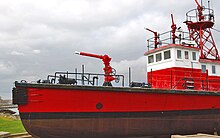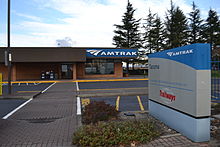Tacoma School of the Arts, opened in 2001, is an arts-focused high school that serves as a national model for educational innovation. SOTA is a public school, part of the Tacoma Public Schools and is one of the first schools in the nation to implement standards based instruction, as well as influence the design of many schools in the nation. SOTA is located in multiple venues around Downtown Tacoma and uses Community Museums and Universities for instructional space. The Science and math institute partners with SOTA, sharing administrators and class space. SAMI and SOTA are the only schools in Tacoma to offer University of Washington in the Classroom college credit options from the University of Washington. Lincoln High School reopened in the fall of 2007 after a $75 million renovation and expansion.[57][58]
The area also has numerous private schools, including the Annie Wright School, Bellarmine Preparatory School, Life Christian Academy, Charles Wright Academy and Seabury School. Tacoma's Covenant High School [59] is associated with Faith Presbyterian Church.[60][61]
Tacoma's institutions of higher learning include the University of Puget Sound, Tacoma Community College, City University of Seattle-Tacoma, Bates Technical College, The Evergreen State College Tacoma Campus, Corban University School of Ministry/Tacoma Campus, and University of Washington Tacoma. Pacific Lutheran University is located in Parkland, just south of the city; nearby Lakewood is the home of Clover Park Technical College and Pierce College.
Cultural attractions
- The Museum of Glass boasts an iconic structure standing near the Thea Foss Waterway; the steel cone of the hot shop is one of the most recognizable structures in the city.
- America's Car Museum opened in June 2012 and displays 300 vehicles in various exhibits on vintage to modern automobiles. The museum pays respects to Harold LeMay's collection, one of the world's largest, with a permanent display entitled "Lucky's Garage". The rest of Harold LeMay's collection can be viewed at the Marymount Event Center, home of the LeMay Family Collection Foundation.
- Tacoma Art Museum was founded in 1935 and reopened in 2003 in a new building on Pacific Avenue in Tacoma – now one of three organizations forming the "museum district" (others are Museum of Glass and Washington State History Museum). It is considered a model for mid-sized regional museums.
- The Broadway Center for the Performing Arts is home to three theaters, two of which are on the National Register of Historic Places. Performing within the three theaters are several performing arts organizations, including the Tacoma Opera, Tacoma Symphony Orchestra, Northwest Sinfionetta, Tacoma City Ballet, Tacoma Concert Band, Tacoma Philharmonic, Tacoma Youth Symphony, Theatre Northwest, and Puget Sound Revels, one of ten Revels organizations nationwide.
Tacoma's Pantages Theater, a remnant of the vaudeville circuit founded by Alexander Pantages.
- The Tacoma Film Festival [62] takes place annually at the Grand Cinema.[63]
- Tacoma is home to the first ever legal marijuana farmers market.[64][65][66]
- The downtown Tacoma farmers' market runs every Thursday, from May through September, in the Theatre District.[67] There are also seasonal farmers markets in the Proctor District (along Sixth Avenue),[68] and in South Tacoma.[69]
- Tacoma hosts part of the annual four-part Daffodil Parade, which takes place every April in Tacoma, Puyallup, Sumner, and Orting.
- Shakespeare in the Parking Lot [70] celebrated its 15th anniversary in 2014. Its motto is "taking the fear out of Shakespeare". They offer both educational opportunities and inspired theater in and around Tacoma.
- Fort Nisqually is a prominent local attraction featuring historical reenactments. The Tacoma Police Department is the site of a public memorial for officers, dominated by the sculptures "Memories in Blue" and "For All They Gave", by James Kelsey.






